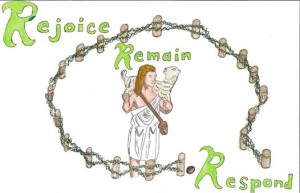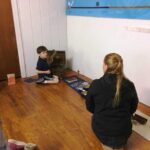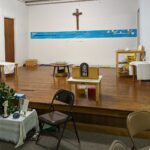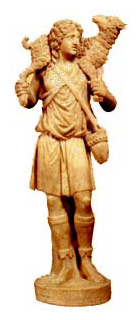For children ages 3 through sixth grade
“In catechesis . . . it is Christ alone Who teaches. Anyone else teaches to the extent that he is Christ’s spokesman.” — Catechism of the Catholic Church # 427
2025-26 Sessions will begin the week of September 21st. Fall registration will be available via our website (Faith Formation tab) or at the Parish Center (Sue’s office) during office hours M-W, F 9:30 am -4:00 pm. We welcome new families to register with our parish and enroll their children in our fall sessions, we welcome our returning families, and all those who have stayed away for a while but are ready to experience our rich and beautiful Catholic faith. Tuition will be $100/child with a $200/family maximum. An additional fee of $50 will be paid in the spring for children who will be celebrating the sacraments of Reconciliation/Eucharist (2nd grade or older). Please note the diocesan policy is all children must have had one full year of religious education directly prior to the year of celebrating sacraments, meaning 2 years of faith formation in total.
Sunday Mass attendance is mandatory for families. God’s Third Commandment is to keep holy the Lord’s Day. There will be a sign-in book at the main entrances to the Churches starting Sept. 6/7 for first graders and older to indicate which Mass they attend each week. If families are off island, the student is required to bring in a bulletin signed by the priest at the Mass they go to. Reception of these Sacraments will be delayed until obligations are met. Families are also asked to participate in the Sacrament of Confession at a minimum during Advent/Lent, Stations of the Cross at least once, to spend time in Eucharistic Adoration and to consider some additional service to the parish and/or community.
Payment and registration forms are expected before sessions start. Payments can be made on our online giving platform, checks are to be made out to: Good Shepherd Parish, or use cash. A new medical information/student release form has to be filled out each year, and bring a copy of the child’s sacrament certificates: if he/she wasn’t baptized here on Martha’s Vineyard, and/or First Communion, if celebrated off island (copies can also be uploaded to the registration form).
Sessions* to be offered for 28 weeks during the 2025-26 school year:
MONDAY: Level II (1-3 grade); Level III (4-6 grade) 3:30-5:30 pm
TUESDAY: Level II (1-3 grade) and Level III (4-6 gr) 3:30-5:30 pm, combined.
WEDNESDAY: Level I (ages 3-K) 3:30-5:00 pm, (starts with 1 hour sessions); Level II (1-3 grade) and Level III (4-6 gr) 5:30-7:00 pm, combined.
THURSDAY: Level II (1-3 grade) and Level III (4-6 gr) 3:30-5:30 pm, combined.
*2025-26 adjustments will be made based on the number of students registering and available catechists.
+ + + + + + +
![]()
Congratulations to our 2024 First Communion students/families:

Isla Blume, Nicholas Curelli, Yago DeMoraes, Davi DeOliveira, Enzo DeOliveira, Thomas Louback, Jackson Lucier, Emme Meuse, Nicholas Parent, Addison Seger and Grace Seguin pictured with Rev. Paul C. Fedak, Beth Mello, catechist and JD and Buddy, altar servers.
+ + + + + + +
What is Catechesis of the Good Shepherd?
“Help me draw close to God by myself”
The Catechesis of the Good Shepherd (CGS) is an approach to the religious formation of children that is rooted in the Bible, the Liturgy of the Catholic Church, and the self-teaching educational principles of Dr. Maria Montessori. This method of nurturing the faith life of children evolved from children themselves. Beginning in Rome in 1954, CGS is the result of a long period of careful observation of children by Dr. Sofia Cavalletti, a Hebrew and Scripture scholar, along with Gianna Gobbi, her Montessori collaborator. With great respect for the dignity of the child and their religious capacities, they developed an atrium – a carefully created environment that helps the child work independently of the catechist/adult as much as possible. It is not a place of religious instruction but of religious life which recognizes the deep bond between God and the child, first; the difference of “pouring in” vs. “calling forth” that which already exists. The atrium certainly is a place of learning, but together they are listening for the one Teacher, who dwells within them. This experience becomes formative in the child’s whole person and generates great joy.
So why have a prepared environment? The small child has the power to absorb what is in his or her environment; what they take in becomes a part of them-enriching their intellectual and spiritual life. The family is the first and most important environment experienced by human beings. It is where cultural, social, religious and moral characteristics are expressed. Vatican II calls the family, “the domestic church,” or the primary educator of children in their faith. The Church is another setting for one’s religious life shared together with a community of believers. In the early Church the atrium was the place where the catechumens were prepared. For us, the atrium is the place in which communities of children live a religious experience together with some adults that prepare them to participate in the larger family community of our parish and the world. Here, children are initiated into the realities of Christian life. Like the prepared environment of the Church, the atrium is a place where the child can listen to the proclamation of the Gospel, then in age-appropriate ways meditate on it, and begin to live it according to the child’s own rhythm. It is here where their work becomes prayer; it is their response to the Good News.

There are different age groups contained in the three levels of atrium offered:
Level I: children ages three through kindergarten
Level II: children in 1st grade through 3rd grade
Level III: children in 4th grade through 6th grade
Catechesis is an ancient word meaning “echoing God’s Word.” The person who does this is known as a catechist. CGS catechists receive 90+ hours of training before leading a CGS session. These catechists find their own spiritual life is fed, as well as the spiritual lives of the children they serve. In many ways, this is adult formation given through the child! To inquire about catechist training, please contact Sue Pagliccia 508-693-0342. CGS continues to spread out through many Christian faiths in countries all over the world. For more information on Catechesis of the Good Shepherd, see the national office website: www.cgsusa.org.
Previous First Communion retreat highlights which we shared with the community beginning with a Sunday 9:00 am Mass.





Are you interested in becoming a CGS Catechist or Aide? Contact Sue Pagliccia 508-693-0342 or by email sue@goodshepherdmv.com
PLEASE NOTE: All persons aged 18 and older must complete the “Essential Three” as outlined in the Diocesan Policy for the Protection of the Faithful in order to minister, work or volunteer in the Diocese of Fall River. Find all the training info and requirements to be met on our website SET Training and Documents and printed copies are also available within the food pantry, or at the main entrances to all 3 island Churches. Volunteers are CORI’d annually. High School students aged 18 or younger will read and sign the Youth Code of Conduct, along with a parent or guardian. Contact Sue Pagliccia, CORI coordinator 508-693-0342 during our regular office hours.
+ + + + + + +
The Role of the Catechist
The catechist sees himself/herself as a servant to the child. Rather than assuming the role of “religion teacher” the catechist strives for an attitude of humility before the child and the wonder of God. We know that God is already present and at work in the children. The catechist prepares the environment called “the atrium” and themselves in order to facilitate the opening of the hearts and minds of the children to the greatest truths of our faith. He/she then chooses a presentation or proclamation based on what she observes in the behavior and responses of the children. He/she guides discussions with questions designed to help the children think more deeply about what a particular proclamation might mean. The catechist “listens to God with the children,” and is always open to any new insights that might come to him/her through them.
A catechist leads the weekly 1-2 hour session with the children in the atrium. We run sessions annually for approximately 28 weeks just after the school year begins through mid-May. It requires 90 hours of training per level, including the writing of album pages. This is a beautiful work for the adult to come closer to God first, while learning how to listen for God with children. Training can be personalized for an individual or for a group with Sue, a certified trainer in all three levels.
The Role of the Aide
The aide assists the catechist in preparation of the environment, in observing the children, and in being available to assist the child, when the child comes to them seeking help to light a candle, read Scripture, etc. The aide also helps maintain order by modeling “atrium behavior” and following the lead of the catechist. This atrium behavior is a quiet way of walking, moving and speaking. We have found that this “slowing down” helps the children quiet themselves and work with great focus and joy. Their work in this environment becomes prayer. For this reason both the catechist and aide regard the work of the children with the highest respect, intruding only when necessary. Montessori “lingo” for the many things available to the children is “materials” and for what they do with those things is “work.”
An aide is expected to be at as many sessions as possible, lending to consistency in the environment, especially for the youngest children ages 3-6. A handbook is given at the start of the year to help orient the adult or student aide in the way of the child.
This is a video of the beloved Pope St. JPII visiting atria in Rome. He reportedly said, “That is the most beautiful homily I have ever witnessed.” Sofia Cavalletti describes his visit in this video, further adding that he said, “It is proof that really the Kingdom of Heaven belongs to the children.” He attentively “listened” to the children as they were immersed in their “works” and saw something special about this unique approach to religious education. Read the article at https://aleteia.org/2019/06/19/john-paul-ii-said-this-was-the-most-beautiful-homily-he-ever-saw/?fbclid=IwAR2yGFPLG8ww_u7nnpjp1ankOfnG5-Eh54s0nPsTgtkucwv0_vhvi9MimcE
Preaching to Children by Dr. Ann Garrido In this 54 minute video, Prof. Ann Garrido addresses homilies for children. After a brief introduction to the Catechesis of the Good Shepherd (05:23), she identifies seven characteristics of children (10:39) and the three great mysteries of life (29:11) to which children relate. At the end of this presentation Dr. Garrido offers five tips for preaching to children (35:18).
